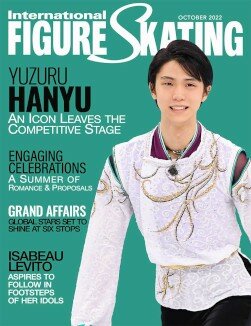

Over the years her students have claimed medals on the Junior Grand Prix and senior international circuit, but until last season Japanese coach Mie Hamada had never produced a senior national champion or a senior World medalist. Satoko Miyahara became the first of Hamada’s charges to claim a coveted national title, and a few months later captured a silver medal at the 2015 World Championships. That momentum has continued this season for the Kyoto-born coach and her team.
Miyahara mined gold at the 2015 U.S. International Figure Skating Classic in Salt Lake City and two of Hamada’s other students, Yuna Shiraiwa and Marin Honda, have both booked places at the Junior Grand Prix Final in their first season competing on the junior circuit.
Hamada, 55, is now constantly on the go with students competing in competitions on different continents, sometimes simultaneously. In September, she went directly from the United States to Germany where another student, Mariko Kihara, was competing at Nebelhorn Trophy. On her return to Japan, Hamada went directly to the Japan Open where Miyahara was competing.
The skating schedule in the coming months has some events conflicting with others Hamada said. “Skate America and Japanese novice nationals are happening at the same time. Following that, I have sectionals (the Western Japan Championships), Japanese junior nationals and NHK Trophy.”
It has been a long road for the dedicated coach, herself a national competitor in the 1970s and early 1980s, and a contemporary of Emi Watanabe, the eight-time Japanese champion and the first Japanese lady to medal at Worlds (a bronze in 1979). The highlight of her career was a 10th place finish at Japanese nationals. “Emi was a much better skater than I was of course,” Hamada said with a laugh. “I wasn’t particularly talented myself. That’s why I think I decided to go to America to find out my own strengths and weaknesses.”
Hamada studied in the U.S. for a time and, whilst there, took advantage of the opportunity to improve her own skating skills. “It was a really good learning experience for me. I worked mainly on my edges and basic skating, things which I wasn’t good at,” she said. After graduating from Kyoto’s Doshisha University 32 years ago, Hamada retired from competitive skating and turned to coaching. “Perhaps it’s because there were things I wasn’t able to do as a skater myself that I was able to become a coach,” Hamada said. “Of course, it’s lovely to end your career having achieved all you wanted, but even if those dreams don’t come true, you can take that energy and use it in another way. I am very fortunate to have been able to do that.”
The 36 skaters Hamada currently has under her wing train at the Kansai University rink in Takatsuki, Osaka. Six of those currently compete internationally. With so many students, Hamada spends up to eight hours a day, six days a week at the rink. Thursday is her only day off. Yamato Tamura, a two-time Japanese men’s champion, coaches alongside Hamada.
She believes that training alongside other strong skaters is a positive for her students when they attend competitions. “When you go to an event, you have to skate with your rivals from other clubs in any case, so it’s good for them to train in such an environment, on a daily basis, where they have to be mindful of doings things at their own pace,” she said. “If you don’t have any rivals, you cannot grow as a skater.”
Even after three decades of coaching, Hamada said she has not lost her passion for training those at the grassroots level. “I just love teaching. I’ve taught many of my skaters since they were beginners. I’ve coached my current junior girls from the moment they first stepped out onto the ice. Just because Satoko has competed at Worlds doesn’t mean that anything has changed very much at all.”
Hamada first came to prominence when she coached Yukina Ōta to the 2003 World junior title and the Four Continents crown in 2004. Despite a promising start to her career, Ōta never made it onto the senior podium at Japanese nationals and was forced to retire in 2008 due to injury.
Hamada has coached Miyahara since age 6. She is full of praise for her highest ranked skater. “Satoko really is a hard worker and truly special. First of all, she never complains and she does what you ask of her,” Hamada said. “Not only that, she practices thoughtfully. She also has a very pleasant disposition. She’s serious and has a good attitude towards learning. Up until now, there has never been a second when I thought she was slacking off. I didn’t start out with the aim that Satoko would skate at the World Championships. It was about improving a little bit every day and training with the idea of what style of skating and what kind of skater she wanted to become. The result of that just happened to be that she was able to go to the World Championships. It was just an extension of what she had been doing day-to-day.”
But, it has not always been plain sailing for Hamada. Just as Japan’s golden age of skating was kicking into high gear in 2005 the rink at which she previously coached in Kyoto closed. She was forced to bundle her students into her own car and drive up to three hours, in some cases, to find practice ice. Even now, the lack of rinks in Japan is something that concerns her. “No matter how much ability you or your coach may have, if there are no rinks it’s a non-starter. I think cutting down the amount of time it takes to commute to a rink and improving the facilities we already have in Japan will contribute to making the competitive standard better.”
While Hamada will go to certain lengths on behalf of her skaters, she also tries to engender a certain amount of independence in them, so that they have the skills to cope with whatever may be thrown at them, not only while they compete, but also when they finish skating. “In competition and in life, nothing goes 100% the way you plan. Because of that, it’s so important to use the time that you have wisely. I also believe it is not in my student’s best interests if they are too dependent on me as a coach. I want them to be able to think positively in whatever situation in which they find themselves.”
What Hamada does instill in her students is a sense of purpose and belief. “People talk about spirit, technique and physical strength a lot in skating. I believe spirit is the most important of these. Being physically fit is important and, of course, so is technique — but without spirit you can’t move up to the next level. I emphasize this with my students, as well as qualities such as perseverance and patience that I want them to develop.”
Hamada tries to preserve the individual style of each of her skaters and encourages them to improve on their weaknesses. “I try and leave the good parts of each skater’s character as it is. “However, as this is a sport, in order to win there are things that you have to work at overcoming. Individuality is important, but I try to not let my skaters develop bad habits. Individuality is a wonderful thing, but having too much can get in the way. It’s hard to judge and find that right balance of just enough personality.”
When asked who she considers is a complete skater, Hamada had no hesitation in naming Carolina Kostner, the 2014 Olympic bronze medalist. “I adore Kostner; her skating, her posture… There are male skaters whose skating I admire, but what I really love to see is a female skater with pretty lines and nice flow. I like how Kostner places her feet and I like skaters who have beautiful edgework. I am quite strict with my students about their footwork and about how they place their feet.”
The level of intensity and competition domestically and the popularity of the sport in Japan are factors that she feels have contributed significantly to the development of Japanese skating and the ability of Japanese skaters to handle pressure so well. “The fact that there is such fierce competition nationally is perhaps the reason why there is such strength and depth. I think we are also fortunate to have so many fans come and watch skating. It really helps the skaters to get used to skating in front of large crowds.”
Hamada has set clear goals for her students to work towards this season. “For Satoko, I’d like to see her on the World podium again. I feel Japanese skaters lack a bit of power compared to skaters from other countries, so I want to see her improve on that. For the juniors (Honda and Shiraiwa), this is their first season since moving up from novice, so I’d like them to get the experience of competing two days in a row. I think that their goal should be to skate well in both their short and free.”
With all the distractions of an insatiable media and enthusiastic fan base in Japan, Hamada is firm in her belief that what a skater does on the ice should do the talking. “I think my students have lately become experts at giving answers to the press. They are able to say things that will get the media and the public excited. They have also become very good at making sure they thank their fans, their federation and their families. “However, I think the only way you can truly express your gratitude is through your performance.”
RELATED CONTENT:
2015 GRAND PRIX FINAL




